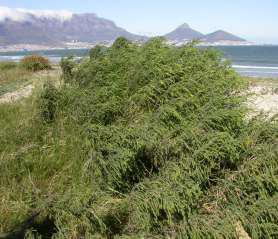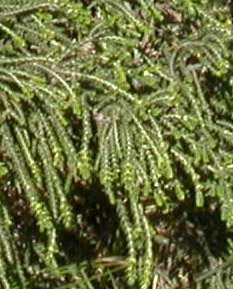Passerina ericoides
Passerina ericoides L.
Family: Thymelaeaceae
Common names: Christmas berry (Eng.); dronkbessie (Afr.)
Introduction
It is a most exhilarating experience seeing Passerina ericoides growing on cliff faces at Cape Point and overlooking the vast Atlantic Ocean, with branchlets trembling in the salt spray. It is clear that this plant is adapted to maritime conditions, also sitting comfortably amongst the coastal dunes from the Cape Peninsula to De Mond in the Bredasdorp District. The plant is characterized by greyish green leaves, greenish flowers and the fruits are fleshy red berries.

Description
Description
Passerina ericoides is a low, rounded, many-stemmed shrublet, branching profusely on new growth. Young branchlets are lax and older branchlets are often rugged. The plants are normally 0.3-1.2 m high. Stems are light greyish brown and the cork is fissured lengthwise. Typically, the growing points are densely white-hairy.
The leaves are slightly succulent, with length ´ width 2.5-2.8 x 0.6-0.7 mm, the upper surface is concave, and the lower is convex. Each spike contains 6-12 flowers and the bracts are normally larger than the leaves.


Flowers are ± 5 mm long, somewhat leathery and greenish during pollination, later turning red. As these plants are adapted to wind pollination, the anthers have large stamens hanging outside the flower.
The fleshy red berries of 5.3 x4.0 mm are the main attraction of this species, often still enveloped by persistent flower parts.
Conservation Status
Status
The conservation status of P. ericoides is considered as Near Threatened (NT) according to the guidelines of the IUCN Species Survival Commission in 2000.
Distribution and habitat
Distribution description
Passerina ericoides occurs from Melkbosstrand along the coast of the Cape Peninsula to De Mond in the Bredasdorp District. It is endemic to the Southwestern and Agulhas Plain Centres within the Cape Floristic Region. This species occurs on littoral sand between rocks, or in dune valleys between the primary and secondary coastal dunes.
Derivation of name and historical aspects
History

The specific epithet ericoides refers to the ericoid appearance of this species indicated by the phrase 'corollae tubus globosus, inflatus-unde et Ericam refert flore', which was used by Linnaeus (1767) in his original description of the species.
In the Catalogue of the Linnaean Herbarium, Savage (1945) made the following inscription 'Tulb. list c. 1769. n.1. det. L.-Blaeria ericoides'. This refers to consignments of bulbs, seeds and herbarium specimens that Rijk Tulbagh sent to Van Royen, the Burmans at Amsterdam and Linnaeus at Uppsala (Gunn & Codd 1981). Jackson (1917-1918) published a list of 203 of the specimens sent to and identified by Linnaeus around 1769. The first inscription on the list is the provisional name Blaeria ericoides, which Savage (1945) believed to be the P. ericoides specimen at the Linnaean Herbarium in London (LINN), unfortunately there is no numbering or any other indication on the specimen to link it with Tulbagh's list (Jackson 1917-1918). As Linnaeus had already described P. ericoides in 1767, the specimen at LINN is probably not part of the Tulbagh collection, but this specimen is currently regarded as the lectotype of P. ericoides.
Ecology
Ecology
Wind pollination is the main distinguishing character of the genus Passerina. The anthers are borne outside the flower and large amounts of pollen are released explosively into the air. Pollen grains are also rounded and light so that they can easily be carried by the wind. The conspicuous, fleshy, red berries are favoured and dispersed by birds, often walking from one plant to the other on the beach.
Uses
Use
Marloth (1925) remarked that P. ericoides was laden with bright, scarlet fruits and that it was often employed as a Christmas decoration. The juicy pulp has a somewhat unpleasant taste, but appears to be harmless (dronkbessie). As early as 1919, Sim recommended P. ericoides as a useful shrub for planting in coastal areas exposed to sea winds. This species occurs on coastal dunes and on the banks of lagoons in the Cape Peninsula and adjacent coastal areas of the Western Cape. The plants are excellent sand binders as they have an extensive root system from which resprouting often takes place. Because human impact and invasion of alien vegetation along the coast of the Cape Peninsula are very high, rehabilitation and conservation of coastal dunes is of vital importance. P. ericoides plants are ideally suited to combat erosion of coastal dunes and can be used as a substitute in coastal areas where alien vegetation is cleared. In their research on the coastal erosion of the Milnerton beaches, Biggs et al. (2001) made use of P. ericoides, occurring on the mobile dunes of this area, as a natural monitor to indicate coastal erosion.
Growing Passerina ericoides
Grow
The rule of thumb for the cultivation of any plant is to adhere to the natural habitat of the plant as closely as possible. P. ericoides is both a resprouter and a reseeder. It has an extensive root system and may be propagated by adventitious roots or suckers. As the fruits are berries, seeds may be available and would probably germinate well in sandy soil. However, these are plants adapted to maritime conditions (wind and salt spray) and they would obviously grow best close to the coast.
Anthony Hitchcock ( pers.comm.) reports that these plants have been grown from seed and cuttings at Kirstenbosch, with seed germinating readily.
References
- Biggs, C., Knight, R., Raitt, L.M. & Keats, D. 2001. The use of vegetation indicators for the assessment of coastal erosion in Milnerton South Africa. 27th Annual Conference of the South African Association of Botanists, RAU, Johannesburg. Unpublished.
- Gunn, M. & Codd, L.E. 1981. Botanical exploration of southern Africa. Balkema, Cape Town.
- Jackson, B.D. 1917-1918. Linné-Tulbagh correspondence in possession of the Linnean Society, being a fifth contribution towards the history of the Linnean collections. Proceedings of the Linnean Society 130, Suppl. 1-13: 5-13.
- Linnaeus, C. 1767. Systema naturae, edn 12,2. Laurentius Salvius, Stockholm.
- Marloth, R. 1925. The flora of South Africa, vol. 2,2. Darter Bros., Cape Town.
- Savage, S. 1945. A catalogue of the Linnaean Herbarium. Linnean Society of London.
- Sim, T.R. 1919. Flowering trees and shrubs for use in South Africa. The Speciality Press of South Africa, Johannesburg.
Credits
Christien Bredenkamp
National Herbarium Pretoria
October 2004.
Plant Attributes:
Plant Type: Shrub
SA Distribution: Western Cape
Soil type: Sandy
Flowering season: Spring
PH: Acid
Flower colour: Green, Red
Aspect: Full Sun
Gardening skill: Average
Special Features:
Horticultural zones







Rate this article
Article well written and informative
Rate this plant
Is this an interesting plant?
Login to add your Comment
Back to topNot registered yet? Click here to register.